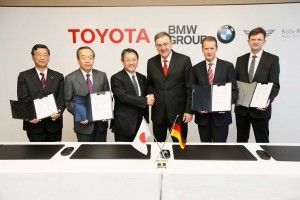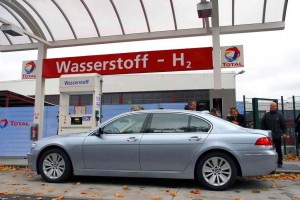
BMW and Toyota officials celebrate their new fuel cell alliance. Shaking hands, in center, are Toyota CEO Akio Toyoda and BMW Chairman Nobert Reithofer.
BMW and Toyota officials today formed a strategic alliance aimed at developing hydrogen-based fuel cell technology – as well as a new “sports vehicle” that will run on the clean, high-mileage gas.
The binding agreement, earlier reported by TheDetroitBureau.com, could help revive interest in the use of hydrogen, a source of energy that some proponents believe will eventually prove the cleanest and most efficient way to power automobiles. Significant technical advancements have been made in recent years and the BMW-Toyota alliance appears aimed at overcoming the remaining challenges.
“Toyota and the BMW Group are seizing this unique chance to lead the industry towards the future of mobility,” declared Dr. Herbert Diess, the BMW board member who will oversee the project. “The binding agreement we signed today moves us one step closer to achieving this vision.”
The agreement is actually just the latest link between BMW and Toyota. In December 2011, they said they would collaborate on the development of “next-generation” lithium-ion batteries. And BMW later agreed to provide Toyota’s European subsidiary with small diesel engines starting in 2014. They’ve also begun working together on developing lightweight materials that can replace steel in order to reduce mass and improve mileage.
But the new agreement is clearly they’re most far-reaching, at least to those who see hydrogen as the ultimate solution to automotive energy and emissions issues.
The smallest atom and the most abundant in the universe, hydrogen can be used in place of gasoline in a slightly modified internal combustion engine or it can power a fuel cell. With the latter technology, the lightweight gas is forced through a permeable membrane covered with platinum and other rare metals that serve as a catalyst. By combining the hydrogen with oxygen from air, a fuel cell stack creates a steady flow of current that can be used to power a vehicle’s electric motors.
In fact, it helps to think of a fuel cell system as “a refillable battery,” says Chris Borroni-Bird, who has worked on fuel cell technology at both General Motors and Chrysler.
What’s perhaps even more compelling, proponents say, is that burning hydrogen, or using it in a fuel cell, creates exhaust consisting of nothing but water vapor. Even battery-powered vehicles create pollution, remotely, if they are charged up from plants that run on coal or some other fossil fuel.
A decade ago, the auto industry was spotlighting hydrogen power the way it has shifted focus to battery technology today. Indeed, Honda began marketing a limited number of FCX fuel cell vehicles in California, while other makers hoped to begin production of their own models by now.
But the bottom dropped out and the industry shifted focus – the Obama Administration notably signaling the transition by re-directing federal funds allocated for fuel cell research to the development of advanced batteries.
As they came closer to their self-imposed deadlines, manufacturers like General Motors, Toyota, Ford and Mercedes-Benz began to discover a series of obstacles. There was, for example, the high cost of the rare metals needed in the fuel cell stack.
“Most, but not all, of the technical problems have been solved” in recent years, suggested Jim Hall, a veteran automotive analyst with 2953 Analytics. In fact, fuel cells are “cost-maturing faster than some advanced battery technologies,” which appears to have encourage BMW and Toyota to form their new alliance.
That said, Hall and other observers warn that hydrogen technology is not necessarily ready for prime time.
The gas may be abundant, especially in space, but on Planet Earth it is found only in molecules such as water or in more complex compounds, such as hydrocarbons – petroleum or natural gas. It takes energy to release hydrogen, though that’s the relatively simple part. More challenging is the distribution of the gas. One possible approach is to ship a relatively simple hydrocarbon from refineries to service stations which would then reform the gas before pumping it into a vehicle’s tank.
That, however, is the other challenge: it is a difficult gas to store in enough volume to provide a vehicle with reasonable range. Engineers are working on various approaches that could include compressing the gas, liquefying it at ultra-low temperatures, or filling a tank with materials that the hydrogen would attach to until needed.
Such issues will likely be part of what BMW and Toyota address with their new alliance. But they also plan to develop a unique sport vehicle specifically to run on hydrogen. It wouldn’t be their first. Toyota has tinkered with fuel cell prototypes in the past and BMW has tested versions of its big 7-Series sedan that use hydrogen as an alternative to gasoline in a relatively conventional internal combustion engine.
As part of their new partnership, BMW and Toyota also plan to advance their work on lightweight materials and to investigate “post-lithium” battery technologies. During his keynote speech at the Los Angeles Auto Show last November, Toyota’s top U.S. executive Jim Lentz hinted the maker is working on an alternative battery chemistry that could store significantly more energy than the lithium batteries used in the maker’s new RAV4-EV.
The German and the Japanese maker aren’t the only ones who continue to look at hydrogen’s potential. Mercedes-Benz recently began testing a small fleet of fuel cell-powered F-Cell vehicles. GM is doing similar work with hydrogen-fueled versions of its Chevrolet Equinox crossover.
Meanwhile, the U.S. Department of Energy recently shifted a small amount of money back into hydrogen research. And German lawmakers recently approved a billion-dollar program to set up a network of service areas around the country where motorists could fill up with hydrogen — or charge their electric vehicles.
But while BMW and Toyota are optimistically hoping to have the basic design of a new hydrogen sports vehicle in place by the end of this year, most industry observers are maintaining a cautious wait-and-see attitude.
As one skeptic recently suggested in an off-the-record aside, “Hydrogen is the fuel of the future…and always will be.”
Perhaps the new alliance will prove him wrong.

